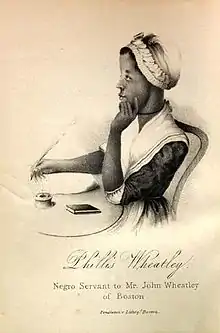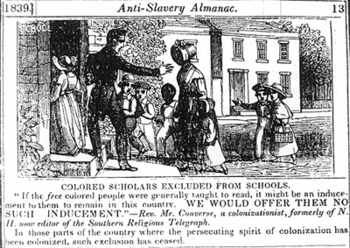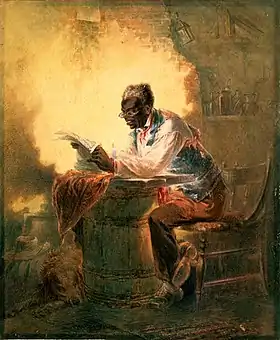Education during the slave period in the United States
The United States is the only country known to have prohibited the education of the enslaved. During the era of slavery in the United States, the education of enslaved African Americans, except for religious instruction, was discouraged, and eventually made illegal in most of the Southern states. After 1831 (the revolt of Nat Turner), the prohibition was extended in some states to free Blacks as well.

Slave owners saw literacy as a threat to the institution of slavery and their financial investment in it; as a North Carolina statute stated, "'Teaching slaves to read and write, tends to excite dissatisfaction in their minds, and to produce insurrection and rebellion."[1]:136 First, literacy enabled the enslaved to read the widely-distributed writings of abolitionists, who informed readers about the slave revolution in Haiti of 1791–1804 and the end of slavery in the British Empire in 1833. It also allowed slaves to discover that thousands of the enslaved had escaped, often with the assistance of the Underground Railroad, to safe refuges in the Northern states and Canada. Finally, literacy was believed to make the enslaved unhappy at best, insolent and sullen at worst. As put by prominent Washington lawyer Elias B. Caldwell:
The more you improve the condition of these people, the more you cultivate their minds, the more miserable you make them, in their present state. You give them a higher relish for those privilegies which they can never attain, and turn what we intend for a blessing [slavery] into a curse. No, if they must remain in their present situation, keep them in the lowest state of degradation and ignorance. The nearer you bring them to the condition of brutes, the better chance do you give them of possessing their apathy.[2]
Nonetheless, both free and enslaved African Americans continued to learn to read as a result of the sometimes clandestine efforts of free African Americans, sympathetic whites, and informal schools that operated furtively during this period. In addition, slaves used storytelling, music, and crafts to pass along cultural traditions and other information.[3]
In the Northern states, African Americans sometimes had access to formal schooling, and were more likely to have basic reading and writing skills. The Quakers were important in establishing education programs in the North in the years before and after the Revolutionary War.[4]
During the U.S. colonial period, two prominent religious groups, Congregationalists and Anglicans, both saw the conversion of slaves as a spiritual obligation, and the ability to read scriptures was seen as part of this process (Monoghan, 2001). The Great Awakening served as a catalyst for encouraging education for all members of society.
While reading was encouraged in religious instruction, writing often was not. Writing was seen as a mark of status, unnecessary for many members of society, including slaves. This is due to the fact that many had to learn how to read to be able to write. Runaway Wallace Turnage "learnt" how to read and write "during that time [of his enslavement] and since [he] escaped the clutches of those held who held [him] in slavery."[5] It is believed that he learned with the help of the slaves who helped him escape to different sites: for example, someone may have taught him how to read directions to get to the next town. Memorization, catechisms, and scripture formed the basis of what education was available.
Despite the lack of importance generally given to writing instruction, there were some notable exceptions; perhaps the most famous of these was Phillis Wheatley, whose poetry won admiration on both sides of the Atlantic.
The end of slavery and, with it, the legal prohibition of slave education did not mean that education for former slaves or their descendants became widely available. Racial segregation in schools, de jure and then de facto, and inadequate funding of schools for African Americans, if they existed at all, continued into the later twentieth century and continues in many areas.
Legislation and prohibitions

South Carolina passed the first laws prohibiting slave education in 1740. While there were no limitations on reading or drawing, it became illegal to teach slaves to write. This legislation followed the 1739 Stono Rebellion. As fears proliferated among plantation owners concerning the spread of abolitionist materials, forged passes, and other incendiary writings, the perceived need to restrict slaves’ ability to communicate with one another became more pronounced. For this reason, the State Assembly enacted the following: "Be it therefore Enacted by the Authority aforesaid, That all and every Person and Persons whatsoever, who shall hereafter teach or cause any Slave to be taught to write, or shall use to employ any slave as a Scribe in any Manner of Writing whatsoever, hereafter taught to write, every such offense forfeit the Sum of One Hundred Pounds current Money." While the law does not clarify any consequences for the slaves who might attain this more highly prized form of literacy, the financial consequences for teachers are clear.
In 1759, Georgia modeled its own ban on teaching slaves to write after South Carolina's earlier legislation. Again, reading was not prohibited. Throughout the colonial era, reading instruction was tied to the spread of Christianity, so it did not suffer from restrictive legislation until much later.[6]
The most oppressive limits on slave education were a reaction to Nat Turner's Revolt in Southampton County, Virginia, during the summer of 1831. This event not only caused shock waves across the slave-holding South, but it had a particularly far-reaching impact on education over the next three decades. The fears of slave insurrections and the spread of abolitionist material and ideology led to radical restrictions on gatherings, travel, and—of course—literacy. The ignorance of the slaves was considered necessary to the security of the slaveholders.[7] Not only did owners fear the spread of specifically abolitionist materials, they did not want slaves to question their authority; thus, |reading and reflection were to be prevented at any cost.
Each state responded differently to the Turner insurrection. Virginians "immediately, as an act of retaliation or vengeance, abolished every colored school within their borders; and having dispersed the pupils, ordered the teachers to leave the State forthwith, and never more to return."[8] While Mississippi already had laws designed to prevent slave literacy, in 1841 the state legislature passed a law that required all free African Americans to leave the state so that they would not be able to educate or incite the slave population. Other states, such as South Carolina, followed suit. The same legislation required that any black preacher would have to be given permission to speak before appearing in front of a congregation. Delaware passed in 1831 a law that prevented the meeting of a dozen or more blacks late at night; additionally, black preachers were to petition a judge or justice of the peace before speaking before any assembly.
While states like South Carolina and Georgia had not developed legislation that prohibited education for slaves, other more moderate states responded directly to the 1821 revolt. In 1833, Alabama enacted a law that fined anyone who undertook a slave's education between $250 and $550; the law also prohibited any assembly of African Americans—slave or free—unless five slave owners were present or an African-American preacher had previously been licensed by an approved denomination.
Even North Carolina, which had previously allowed free African-American children to attend schools alongside whites, eventually responded to fears of insurrection. By 1836, the public education of all African Americans was strictly prohibited.
Education and subversion in the Antebellum Era

In examining the educational practices of the period, it is difficult to ascertain absolute figures or numbers. However, Genovese (1986) has explored some of these areas and offers some interesting insights.
W. E. B. Du Bois and other contemporaries estimated that by 1865 as many as 9% of slaves attained at least a marginal degree of literacy. Genovese comments: "this is entirely plausible and may even be too low" (p. 562). Especially in cities and sizable towns, many free blacks and literate slaves had greater opportunities to teach others, and both white and black activists operated illegal schools in cities such as Baton Rouge, New Orleans, Charleston, Richmond, and Atlanta. Some notable educators included:
- John Berry Meachum, a black pastor, who created a Floating Freedom School on the Mississippi River to circumvent anti-literacy laws.[9] James Milton Turner attended his school.
- Margaret Crittendon Douglass, a white woman who published a memoir after she was imprisoned in Virginia for teaching free black children to read.[10]
- Catherine and Jane Deveaux, a black mother and daughter who, with the Catholic nun Mathilda Beasley, ran underground schools in Savannah, Georgia.[11]
Even on plantations, the regular practice of hiring out slaves helped spread literacy. As seen in Frederick Douglass's own narrative, it was common for the literate to share their learning.[12] As a result of the constant flux, few if any plantations would fail to have at least a few literate slaves.
Fredrick Douglass states in his biography that he understood the pathway from slavery to freedom and it was to have the power to read and write. In contrast, Schiller wrote: "After all, most educated slaves did not find that the acquisition of literacy led inexorably and inevitably to physical freedom and the idea that they needed an education to achieve and experience existential freedoms is surely problematic."[13]

As early as the 1710s slaves were receiving Biblical literacy from their masters. Enslaved writer Phillis Wheatley was taught in the home of her master. She ended up using her skills to write poetry and address leaders of government on her feelings about slavery (although she died in abject poverty and obscurity). Not everyone was lucky enough to have the opportunities Wheatley had. Many slaves did learn to read through Christian instruction, but only those whose owners allowed them to attend. Some slave owners would only encourage literacy for slaves because they needed someone to run errands for them and other small reasons. They did not encourage slaves to learn to write. Slave owners saw writing as something that only educated white men should know.[14] African-American preachers would often attempt to teach some of the slaves to read in secret, but there were very few opportunities for concentrated periods of instruction. Through spirituals, stories, and other forms of oral literacy, preachers, abolitionists, and other community leaders imparted valuable political, cultural, and religious information.
There is evidence of slaves practicing reading and writing in secret. Slates were discovered near George Washington's estate in Mount Vernon with writings carved in them. Bly noted that "237 unidentified slates, 27 pencil leads, 2 pencil slates, and 18 writing slates were uncovered in houses once occupied by Jefferson's black bond servants." This shows that slaves were secretly practicing their reading and writing skills when they had time alone, most likely at night. They also believe slaves practiced their letters in the dirt because it was much easier to hide than writing on slates. Slaves then passed on their newly-learned skills to others.[15]
Even though mistresses were more likely than masters to ignore the law and teach slaves to read, children were by far the most likely to flout what they saw as unfair and unnecessary restrictions. While peer tutelage was limited in scope, it was common for slave children to carry the white children's books to school. Once there, they would sit outside and try to follow the lessons through the open windows.
Free black schools

In the 1780s a group called the Pennsylvania Society for Promoting the Abolition of Slavery (PAS) took on anti-slavery tasks. They helped former slaves with educational and economic aid. They also helped with legal obligations, like making sure they didn't get sold back into slavery. Another anti-slavery group, called the New York Manumission Society (NYMS), did many things towards the abolition of slavery; one important thing they did was establish a school for free blacks. “The NYMS established the African Free School in 1787 that, during its first two decades of existence, enrolled between 100 and 200 students annually, registering a total of eight hundred pupils by 1822.” The PAS also instituted a few schools for the free blacks and also had them run only by freed African Americans.
They were taught reading, writing, grammar, math, and geography. The schools would have an annual Examination Day to show the public, parents, and donors the knowledge the students had gained. It mainly was to show the white population that African Americans could function in society. There are some surviving records of what they learned in the free schools. Some of the work showed that they were preparing the students for a middle-class standing in society. Founded in 1787, the African Free School provided education for blacks in New York City for more than six decades.[16]
In 1863, an image of two emancipated slave children, Isaac and Rosa, who were studying at the Free School of Louisiana, was widely circulated in abolitionist campaigns.[17]
References
- Jay, William (1835). An Inquiry Into the Character and Tendency of the American Colonization, and American Anti-slavery Societies (2nd ed.). New York: Leavitt, Lord & Co.
- Torrey, Jesse (1822). American slave trade; or, An Account of the Manner in which the Slave Dealers take Free People from some of the United States of America, and carry them away, and sell them as Slaves in other of the States; and of the horrible Cruelties practiced in the carrying on of this infamous Traffic: with Reflections on the Project for forming a Colony of American Blacks in Africa, and certain Documents respecting that Project. London: J[ohn] M[organ] Cobbett. p. 102.
- Randall, Vernellia R. (2000). "Excerpts from: Monique Langhorne, the African American Community: Circumventing the Compulsory Education System , 33". Beverly Hills Bar Association Journal 12-31, 13-17. The University of Dayton School of Law. Retrieved 25 April 2012.
- Sambol-Tosco, Kimberly (2004). "The Slave Experience: Education, Arts, & Culture". PBS.org. Retrieved 6 May 2020.
- Blight, David W. (15 January 2009). A Slave No More: Two Men Who Escaped to Freedom, Including Their Own Narratives of Emancipation. Boston: Mariner Books. p. 214. ISBN 978-0-15-101232-9.
- (Monaghan, p. 243)
- (Albanese, 1976)
- Allen, William G. (1860). A Short Personal Narrative. Sold by the author. Dublin. p. 6.
- "Meachum, John Berry 'J. B.'". Notable Kentucky African Americans Database. Retrieved December 19, 2018.
- "The case of Mrs. Margaret Douglass". Africans in America. Judgment Day. Part 4: 1831–1865. WGBH-TV. 1998.
- Mary Ellen Snodgrass, Civil Disobedience: An Encyclopedic History of Dissidence in the United States Routledge, Apr 8, 2015, p. 105
- "Frederick Douglass, 1818-1895. Narrative of the Life of Frederick Douglass, an American Slave. Written by Himself". docsouth.unc.edu. Retrieved 2016-01-17.
- Schiller, Ben (Spring 2008). "Learning Their Letters: Critical Literacy, Epistolary Culture, and Slavery in the Antebellum South". Southern Quarterly. 45 (3): 11–29.
- Bly, Antonio T (Fall 2008). "Pretends He Can Read: Runaways and Literacy in Colonial America, 1730-1776". Early American Studies. 6 (2): 261–294. doi:10.1353/eam.0.0004. S2CID 144994154.
- Bly, Antonio T (Fall 2008). "Pretends He Can Read: Runaways and Literacy in Colonial America, 1730-1776". Early American Studies. 6 (2): 261–294. doi:10.1353/eam.0.0004. S2CID 144994154.
- Polgar, Paul J (Summer 2011). "To Raise Them to an Equal Participation". Journal of the Early Republic. 31 (2): 229–258. doi:10.1353/jer.2011.0023. S2CID 143971087.
- Paxson, Charles (January 30, 1864). "To the Editor of Harper's Weekly". Harper's Weekly.
- Albanese, Anthony. (1976.) The Plantation School. New York: Vantage Books.
- William L. Andrews, ed. (1996). The Oxford Frederick Douglass Reader. New York: Oxford University Press.
- Bly, Antonio T. "Pretends he can read": Runaways and Literacy in Colonial America, 1730-1776." Early American Studies 6, no. 2 (Fall 2008): 261-294. America: History & Life, EBSCOhost (accessed October 27, 2014).
- Genovese, Eugene. (1976). Roll, Jordan, Roll. New York: Vintage Books.
- Monaghan, E. J. (2005). Learning to Read and Write in Colonial America. Boston: University of Massachusetts Press.
- Palmer, R. Roderick (1957). "Colonial Statues and Present Day Obstacles Restricting Negro Education". The Journal of Negro Education. 26 (4): 525–529. doi:10.2307/2293515. JSTOR 2293515.
- Polgar, Paul J (2011). ""To Raise Them to an Equal Participation": Early National Abolitionism, Gradual Emancipation, and the Promise of African American Citizenship". Journal of the Early Republic. 31 (2): 229–258. doi:10.1353/jer.2011.0023. S2CID 143971087.
- Schiller, Ben (2008). "Learning Their Letters: Critical Literacy, Epistolary Culture, and Slavery in the Antebellum South". Southern Quarterly. 45 (3): 11–29.
- Webber, Thomas. (1978). Deep Like Rivers: Education in the Slave Quarter Community 1831-1865. New York: W.W. Norton & Company, Inc.
- Woodson, C.G. (1915). The Education of the Negro Prior to 1861: A History of the Education of the Colored People of the United States from the Beginning of Slavery to the Civil War. New York: G.P. Putnam's Sons.
External links
- Harvard Educational Review, SELF-TAUGHT African American Education in Slavery and Freedom by HEATHER ANDREA WILLIAMS CHAPEL HILL: UNIVERSITY OF NORTH CAROLINA PRESS, 2005
- Kimberly Sambol Toscol, The Slave Experience: Education, Arts, & Culture, PBS.com
- http://www.aaihs.org/rethinking-early-slave-literacy/